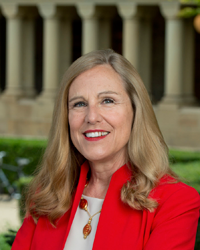Teaching is complex work that demands the same respect accorded to other professions, Dean Deborah Stipek says in her discussion of the May/June issue of the "Educator." Like business, law and medicine, it demands specialized training to gain the necessary expertise. Stanford Graduate School of Education is showing how to prepare people to excel at it — and to help them to improve throughout their careers, she adds.

Over the last few years a consensus has emerged that quality of teaching is the most vital factor in a child’s education. There is not a consensus, however, on how to promote excellent teaching.
In forums on this issue, the loudest voices fall roughly into two camps. One focuses on who becomes teachers in the United States, and it casts the solution as simply recruiting the best and the brightest. The other concentrates on problems in the way the nation prepares its teachers, and calls for better training for teachers before they enter the classroom.
We need to do both, and we need to do more. We also have to support continuous learning over the course of teachers’ careers; we have to deepen our understanding of what makes for effective teaching and learning; and we have to improve the status of teachers in the United States.
The May/June issue of the Educator highlights the Graduate School of Education’s efforts to drive such changes in the teaching profession.
One feature, including both story and video, covers the Hollyhock Fellowship, a free two-year program that brings to campus some 200 early-career teachers from several dozen high-need secondary schools in 17 states: With its intensive summer workshops and its online mentoring network, the Hollyhock program serves as a model for how professional development programs can develop teacher-leaders.
In a complementary effort, GSE faculty and students are working with the San Francisco Unified School District as it implements a middle school math curriculum aligned to the new Common Core State Standards. Rather than have teachers depend on training outside the district, the goal is to build the districts own capacity for professional development. Professors Hilda Borko and Janet Carlson explain in a Q&A in the Educator that the Stanford/SFUSD team will not only educate select teachers about this ambitious way of teaching math, but it also will prepare them to teach their colleagues. This professional development program could be more sustainable and could be a model for other districts. A $3 million grant from the National Science Foundation will support the roll out of the new math curriculum in San Francisco and help fund research to evaluate the strengths and weaknesses of the professional development.
I’d also like to point to news of another grant, this one from the Department of Education to Stanford and two other universities, to support a study of an alternative to traditional classroom teaching. The researchers are examining how Florida’s virtual schooling program, one of the largest state-sponsored K12 online education initiatives, is affecting student performance. In addition, the Educator reports on other efforts to improve how we teach and learn: the impact of Mandarin immersion classes, brain wave research on how learning affects neural circuitry, and a new curriculum about the tragic events in Baltimore and Ferguson, Missouri.
These different projects reflect the GSE’s long-held commitment to advancing the study and practice of teaching, though the stakes are now higher than ever. The Common Core and the demands of the global economy require students to achieve higher levels of thinking and understanding. The need for outstanding teaching has never been greater, but the profession of teaching seems to be slipping in appeal. Teacher job satisfaction, according to a 2013 report, had reached its lowest point in 25 years. The enrollment in teacher preparation programs nationwide has declined, with California suffering one of the most severe falls — a drop of 74 percent from 2002 to 2013. Teacher turnover is high — about 41 percent leave the classroom in their first five years — and the churn is worst at the schools with the most disadvantaged students.
Stanford honors teachers, and the GSE wants to promote respect for the profession. That’s why we celebrate Judy Avery’s gift establishing the GSE’s forgivable loan program, which sends a message that teachers deserve the same financial security that is accorded to professionals in business, medicine and law. And that’s why the 2015 Cubberley Lecture — “Reimagining the Profession of Teaching” — drew attention to the revered place that teachers hold in other nations. (See the story and video about the May 7 event with Dana Goldstein, author of The Teacher Wars; Elizabeth Green, author of How to Build a Better Teacher; and Linda Darling-Hammond, the Charles E. Ducommun Professor of Education, Emeritus.)
As the Cubberley Lecture conveyed, teaching is a complex endeavor that requires dedication and lifelong training. The GSE selects gifted and talented students who are well suited for the profession, and in the Stanford Teacher Education Program (STEP), they gain the skills that they need to hit the ground running on their first day of work. Scaling the exemplary teacher preparation and support we provide is a challenge. But the GSE’s success demonstrates the value of investing in teaching, and programs such as STEP, the partnership with SFUSD and Hollyhock are developing and testing effective strategies and offering templates that others could implement. Seeing what we have been able to do here gives me hope for change in the educational landscape throughout the nation in the years to come.